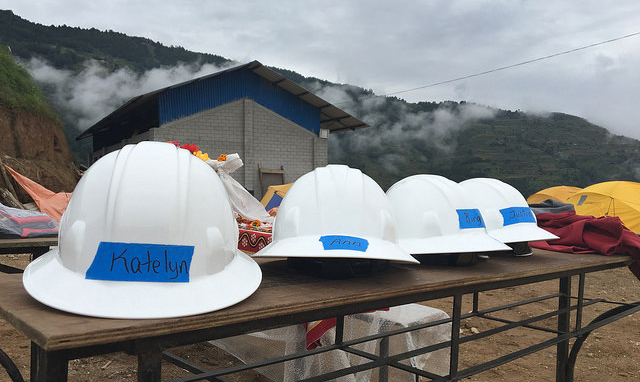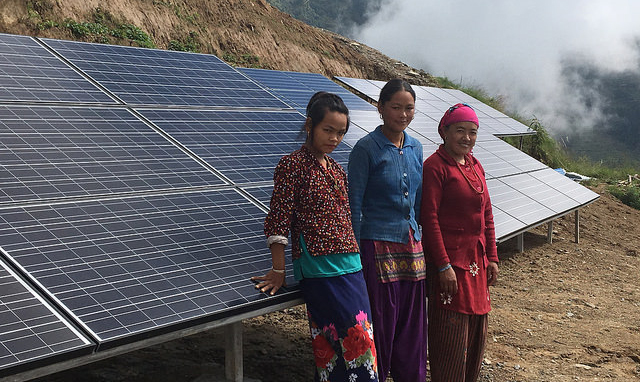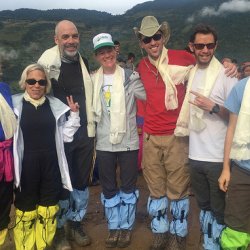During the first two weeks of October, GRID Alternatives completed its first project in Nepal, bringing power to a community that is still rebuilding after last year’s earthquakes. GRID’s International Program Director Jenean Smith writes about her experience.
The old man saw me looking at the millet plants with my flashlight and said “coto” in Nepali, pointing at them with his knife. We were almost to the village of Dhapchung, after 15 hours of traveling by bus, then truck, then on foot. We hiked down the last stretch of the road, toward the one bright light coming from a small solar system in Dhapchung. When we arrived, the community greeted us with flower necklaces, dhakas (local hats) and silk scarves. That night our group of 14 slept in tents at the top of the village and awoke to a breathtaking view of green terraced hills leading to a river barely visible in the valley below.
For the next three days, we worked with technicians from Gham Power, a Nepali solar company, to mount pre-pay meters on steel power poles we wired to each home. We wired 24 industrial batteries, installed breakers and breaker boxes in all 42 homes, and connected the solar panels to the inverters and charge controllers in the small powerhouse built for the project. The people of the village made bamboo ladders so we could attach the meters to the overhead wires.
 Volunteers worked with Digo Bikas Institute to talk with families about income opportunities that will be available once the microgrid is complete. The villagers are excited about the possibilities, mentioning electric sewing machines, a food sealer, a printer, and a community movie night, as well as the saw mill and grain mill they plan to build.
Volunteers worked with Digo Bikas Institute to talk with families about income opportunities that will be available once the microgrid is complete. The villagers are excited about the possibilities, mentioning electric sewing machines, a food sealer, a printer, and a community movie night, as well as the saw mill and grain mill they plan to build.
Dhapchung is terraced, so each row of houses sits above another. Many houses were destroyed by the 2015 earthquakes and the community was in the process of rebuilding them. As we visited each house, huffing and puffing as we went up and down the terraces, we were invited into homes and offered large cucumbers, fermented buffalo milk, a corn drink called chang drink, and spirits made at the local distillery. Everyone in the community was open and kind, and the children ran after us showing us the easiest paths and the fastest way from one house to the next.
At night, we had dinner in the school prepared for us by the men from Beyul Travel, enjoying trekker food along with local corn, millet and potatoes. And after a hard day’s work, the village showed us how they have fun, lighting a bonfire and singing and dancing for hours. The people of Dhapchung speak Tamang, but there was no language barrier when the dancing started. Everyone was welcome to have fun and let loose.
 We turned on the 16kW solar microgrid in the evening of our last night in Dhapchung, and we had dinner in the school with the lights on. We were very sad to leave the village the next morning. Faces that were unknown to us when we arrived had become familiar. The kids had become our guardians, watching after us everywhere we went. The kindness and humility of the people in Dhapchung will be with us forever, and we hope the solar system provides reliable clean electricity and creates more opportunities for the people of Dhapchung.
We turned on the 16kW solar microgrid in the evening of our last night in Dhapchung, and we had dinner in the school with the lights on. We were very sad to leave the village the next morning. Faces that were unknown to us when we arrived had become familiar. The kids had become our guardians, watching after us everywhere we went. The kindness and humility of the people in Dhapchung will be with us forever, and we hope the solar system provides reliable clean electricity and creates more opportunities for the people of Dhapchung.

